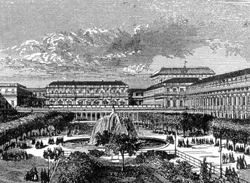While today a certain type of traveler heads for Las Vegas, Havana, or Bangkok, in the 18th century, Paris was the unrivaled sin city of Europe. Even the uproar of the 1789 revolution, which was initially supported by many French aristocrats, only helped promote its hedonistic reputation — at least until the Terror of 1793-4 squelched tourism.
No sooner had the Bastille fallen than the capital was flooded with foreigners, curiosity-seekers, and political delegates from the French provinces, all looking to enjoy carnal delights while they savored the newly-democratic ambiance. To help out-of-town gentlemen navigate the underbelly of the city — and to control the problem of over-charging — a unique and practical guidebook was quickly published for those seeking prostitutes in the Palais Royal, the enormous entertainment complex that doubled as a red-light district. Today, this pocket-sized opus — List of Compensation for the Ladies of the Palais Royal, and District, and for the Other Regions of Paris, Comprising Names and Addresses — provides an unusually intimate glimpse of the 18th-century sex industry.
The anonymous author notes that one lady of the night, nicknamed La Paysanne or “the country girl,” charges a very reasonable six livres for her services, plus a bowl of punch. (The guide notes that La Paysanne only works during the day, preferring to sleep at nights). Mme Dupéron and her four friends at salon No. 33 are far more expensive, he warns, at 25 livres, while a certain Georgette is definitely to be avoided if she is drinking (“a perfect disgrace”). The classy La Bacchante is famous for her beauty and charges on a sliding patriotic scale — six livres for young revolutionaries, 12 livres for a “mature man.” La Bacchante can also be hired as a consort on a weekly basis: Not only will she provide young foreigners with an excellent erotic education, she will help them shop for decent clothes in the best boutiques and teach them the niceties of etiquette.
For the new revolutionary era, the Palais Royal was soon renamed the Maison Egalité, Equality House. While prostitutes thronged the sprawling complex, their presence did not deter visits by young couples or families. Conveniently placed opposite the Louvre, the palace’s gracious open spaces included gardens, cafes, clothing boutiques, theaters, billiards halls, and amusement-park attractions. There was a natural history museum, the world’s first wax museum (where the young Madame Tussaud was apprenticed), a zoo, and freak shows where you could gawk at a 632-pound giant and 200-year-old woman. There were astronomical machines showing planetary movements and a vehicle pulled by a mechanical deer, which would go backwards or forward on command. For refreshments, you could head to the Café Mécanique, where steaming mocca coffee was pumped through a pipe in the middle of each table.
According to historians’ best guesses, the prostitutes continued to ply their trade untroubled by the Revolution’s increasing violence. Less lucky was the owner of the Palais Royale, the Duke of Orléans, an aristocrat who dubbed himself “Citizen Equality” and tried to ride out the waves of fury that had been unleashed. In 1793, he voted for the death sentence of his cousin, King Louis XVI, but was sent to the guillotine himself about ten months later — one of 2,800 Parisians to do so. Today, the Palais Royale is a pleasant and remarkably unsleazy tourist attraction set around a quiet lawn. • 27 November 2007
SOURCE/FURTHER READING: Isherwood, Rober M., Farce and Fantasy: Popular Culture in Eighteenth-Century Paris, (New York, 1986).




